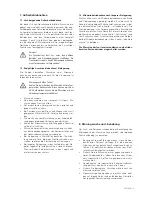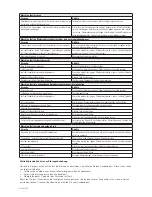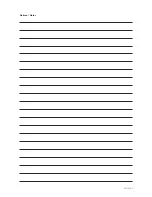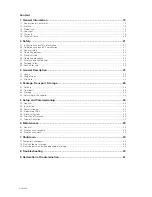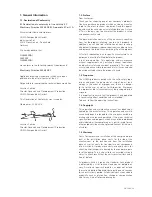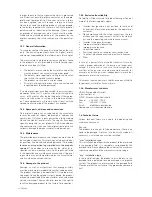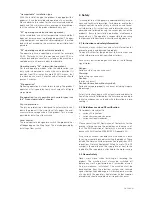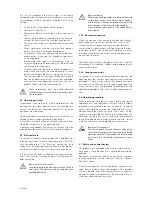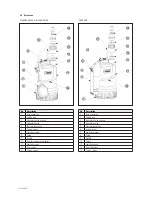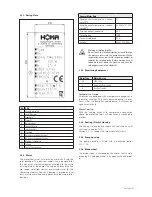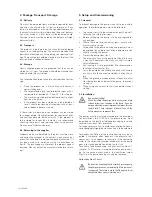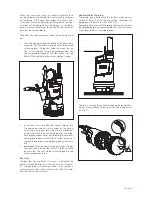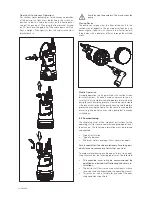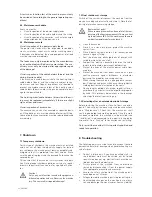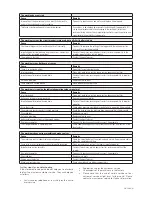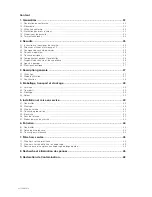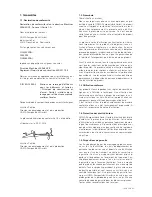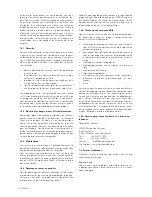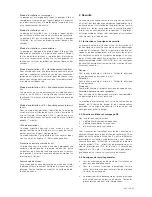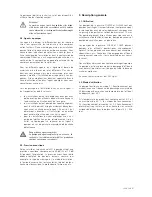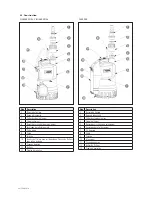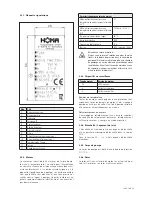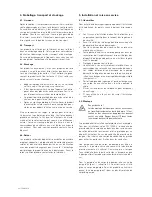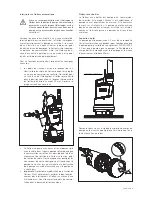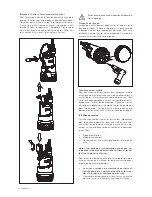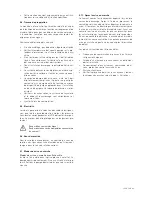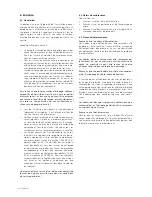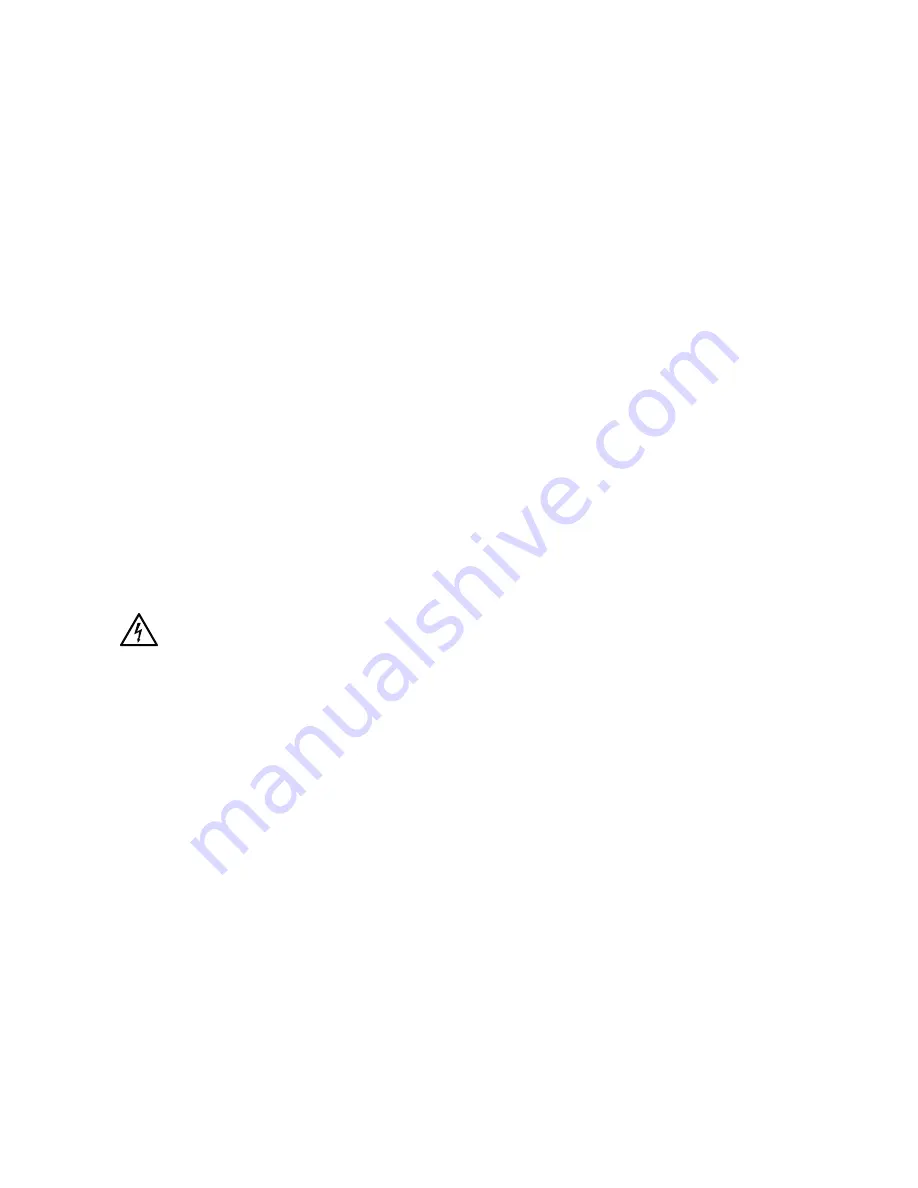
EngliSH | 29
5.4. Preparatory Work
The machine has been designed and assembled accord-
ing to the state of the art, so that it works reliably for a
long time under normal operating conditions. However, a
prerequisite for this is that you follow all the requirements
and instructions.
Please check the following points:
•
Cable guidance – no loops, slightly taught
•
Check the temperature of the conveying medium and
immersion depth
•
If a hose is used on the discharge side, this is to be
rinsed through with clean water before it is used, so
that there are no deposits or blockages
•
For a wet setup, the pump sump is to be cleaned
•
The pipework system on the discharge side and suc-
tion side is to be cleaned, and all gate valves are to
be opened.
•
The pump housing must be ventilated, i.e. it must be
completely filled with the medium and it must not
contain any more air. The ventilation may be done
by suitable ventilation equipment in the system or,
if present, by bleeder screws on the pressure joint.
•
Check the accessories, pipework system and the at-
tachment device for correct, firm seating.
5.5. Electrical System
When laying and selecting the electrical lines and when
connecting the motor, the relevant local and VDE regula-
tions are to be followed. The motor must be protected by
a motor overload switch.
Danger due to electricity!
There is danger of death due to improper handling
of electricity!
5.6. Direction of Rotation
For 1Ph motors, checking the direction of rotation is not
necessary, as it can always run with the correct direction
of rotation.
5.7. Type of Activation
Types of Activation with Plug
Plug the plug in the socket provided for this purpose.
Pump runs directly, if the sensor is triggered.
5.7.1. After Activating
The rated current is briefly exceeded during the starting
process. After this process has finished, the operating
current should no longer exceed the rated current. If the
motor does not start immediately after switching on, it
must be shut down immediately. Before switching on
again, the pauses must be maintained according to the
technical data. If there is a new fault, the machine must
be shut down again immediately. A new activation pro-
cess must only be started after troubleshooting.
The following points should be checked:
•
Switching frequency and pauses (see Technical Data)
•
Air introduction on admission side, a baffle plate may
have to be attached
•
Minimum water covering, level control, protection
against dry running
•
Quiet running
•
Check for leaks, take any necessary steps according
to the “Maintenance” chapter
6. Maintenance
6.1. General
The pump as well as the entire system must be inspect-
ed and maintained at regular intervals. The interval of the
maintenance is determined by the manufacturer and ap-
plies for the general conditions of use. The manufacturer
must be contacted in the event of aggressive and/or abra-
sive pumped mediums, since the interval could be short-
ened in these cases.
The following points must be noted:
•
The operating instructions must be available to the
maintenance personnel and must be followed. Only
maintenance work and measures listed here must be
carried out.
•
All maintenance work, inspection work and cleaning
work on the machinery and the system must be car-
ried out with due diligence, at a safe working place
and by trained qualified personnel. The required pro-
tective gear must be worn. The machinery must be
disconnected from the power supply for all work.
Unintentional start must be prevented. Furthermore
the respective protective measures according to the
Employers’ Liability Association regulations, BGV/the
Statutory Accident insurance, GUV must be complied
with when working in basins and/or containers.
Ensure that sling gear, ropes and the safety equipment
of the hand winch are technically sound. The work
must only be started when the auxiliary hoisting gear
is technically in order. Failure to carry out these checks
may jeopardize your life!
•
f easily inflammable dissolvers and cleaning materials
are used, open fire, open light as well as smoking are
prohibited.
•
Ensure that the required tools and materials are read-
ily available. Tidiness and cleanness ensure safe and
proper work on the machinery. Remove used clean-
ing materials and tools from the machinery after the
work has been carried out. Keep all materials and
tools in a dedicated place.
•
Service media (such as for example oils, lubricants,
etc.) must be captured in a suitable container and
must be disposed of according to the regulation
75/439/EEC and writ §5a, 5b abfG, Waste Avoidance
and Management Act). Respective protective cloth-
ing must be worn when carrying out cleaning work
and maintenance work. This must be disposed of ac-
cording to waste catalogue TA 524 02 and EC direc-
tive 91/689/EEC. Only lubricants recommended by
the manufacturer must be used. Oils and lubricants
must not be mixed. Only use manufacturer’s original
parts.
Summary of Contents for C260WA
Page 17: ...DEUTSCH 17 Notizen Notes ...
Page 63: ...63 Notizen Notes ...
Page 64: ...64 Notizen Notes ...
Page 65: ...65 Notizen Notes ...
Page 70: ...70 ...

